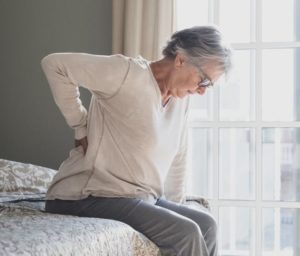 After age 30, your bones lose more tissue than they generate. For adults 65 and older, this process increases the risk of developing osteoporosis. The condition compromises mobility, leading to more broken bones and fractures. Here’s what you should know.
After age 30, your bones lose more tissue than they generate. For adults 65 and older, this process increases the risk of developing osteoporosis. The condition compromises mobility, leading to more broken bones and fractures. Here’s what you should know.
How Osteoporosis Develops
Your bones are in a constant state of renewal, in which new tissue forms and the presence of calcium and phosphorus strengthens its structure. During the first few decades of life, your body generates new tissue at a faster rate than what’s broken down and reabsorbed.
This pattern reverses as you grow older, resulting in larger holes among the tissue’s honeycomb texture and a thinner, harder composition that’s more likely to break.
Accelerated progression or bone density loss typically leads to an osteoporosis diagnosis. Over 50 million Americans currently live with this condition, a number predicted to rise in response to the country’s growing senior population.
Hormonal changes can also influence osteoporosis. Menopause in women causes estrogen levels to sharply decline and bone loss to increase. Despite this statistic, men are at risk for this disease too. Genetic and lifestyle factors can contribute to osteoporosis in all people.
Impact of Osteoporosis
Unless your bone density is routinely measured, osteoporosis can go undetected for years until you experience a broken bone. Understand how this condition can affect quality of life.
Early Signs
Even before a fracture or complete break, osteoporosis can influence your health and quality of life. Early manifestations of this condition include:
- Lower back pain without a defined cause
- Shortness of breath and breathing difficulties
- Changes in posture
- A decline in your height
Fractures and Broken Bones
The brittle, thinner bone texture increases your fracture risk, including:
- Fragility fractures
- Hip fractures
- Vertebral and spinal fractures
- Shoulder, upper arm and wrist fractures
Furthermore, your bones don’t recover like they used to once you have been diagnosed with osteoporosis. After 18 months, roughly half of all patients make a complete recovery but extensive rehabilitation is often required.
For those who do not reach this point, long-term care becomes essential for one quarter of them, while others live with permanent disability. Patients in both groups also have higher risks for a second fracture.
Quality of Life Concerns
Following recovery, a fracture or broken bone can:
- Compromise independence and walking ability
- Come with a risk of physical deformity, based on how the tissue repairs itself
- Not fully heal and leave a patient contending with chronic pain
- Increase fatality risks
Patients are also more likely to experience subsequent injuries from slips and falls.
Osteoporosis Treatment
To diagnose osteoporosis, your doctor may recommend a bone density test, which uses dual-energy X-ray absorption to compare the health of your bone tissue to that of an average young adult.
From here, patients are often steered toward:
- Medication: Bisphosphonates and biologics help slow the pattern of bone loss. Due to side effects, medications are generally prescribed when your bone scan shows a
-2.5 or lower score. Hormone treatments may additionally be recommended. - Supplements: If your T-score is not in the low range yet, your doctor may recommend increasing your calcium and vitamin D intake. These levels can be obtained through prescription and over-the-counter supplements, as well as diet.
- Exercise: Get more physical activity to build muscle strength, while improving bone density and balance. Try walking, jogging and low-impact weight-bearing exercises.
- Diet and Lifestyle Changes: Reducing caffeine and alcohol intake can help preserve your bones. If you’re a smoker, you’ll be asked to give up the habit.
- Your Home: Due to the relationship between fractures and falls, you may need to make updates to your home. Changes may include adding non-skid mats, assistive devices like grab bars and controlling clutter.
Concerned about osteoporosis? For medical care or to explore options for short-term rehabilitation, contact Avon Health Center today.
« 2023 Holiday Fair

